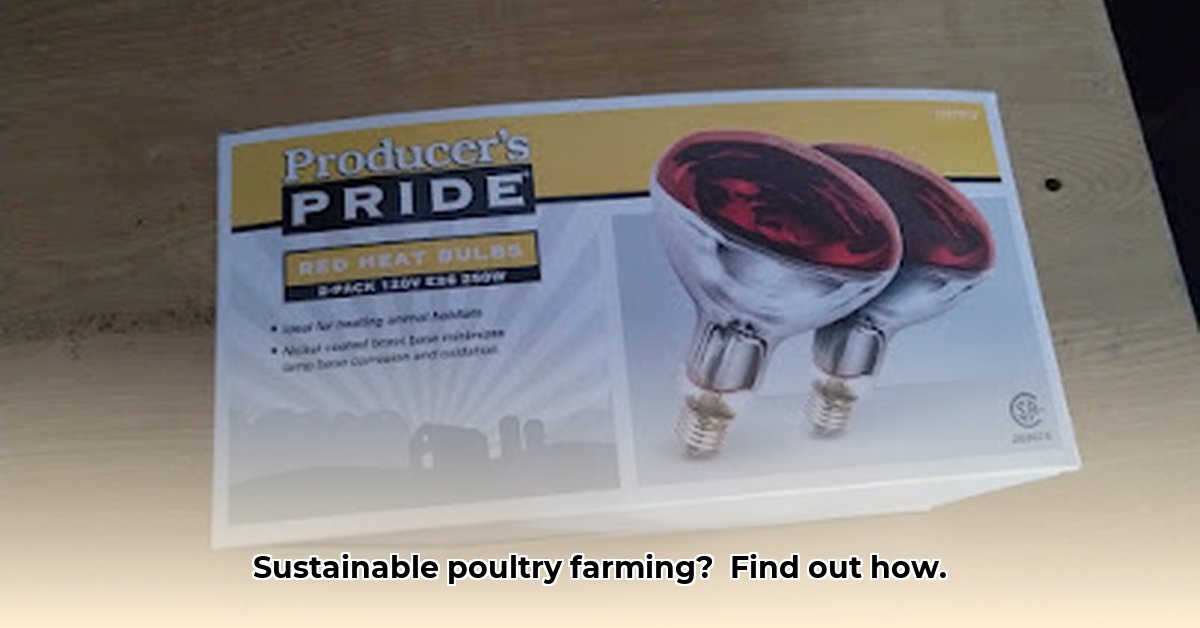
Raising healthy chicks requires providing a safe and warm environment. A brooder lamp, readily available at Tractor Supply and similar retailers, is essential for this process. For more ideas on building a coop, check out this helpful resource. This guide provides practical steps for selecting and utilizing brooder lamps in an energy-efficient and environmentally conscious manner.
Choosing the Right Brooder Lamp: Efficiency and Sustainability
Selecting an energy-efficient brooder lamp is the first step toward sustainable poultry farming. Tractor Supply offers various options, each with different energy consumption characteristics.
Wattage: The wattage determines the heat output. While higher wattage provides more heat, it consumes more energy. Start with a lower wattage and increase it as needed, always monitoring chick comfort. High wattage isn't always better; it needs to match the size of your brooder and the ambient temperature. Overheating can be detrimental to your chicks.
Lamp Type: Incandescent, fluorescent, and LED lamps are available. While LEDs have a higher upfront cost, their significantly longer lifespan and higher lumens per watt (lpw) – a measure of light output per unit of energy – result in substantial long-term energy savings. Additionally, infrared lamps offer gentle, even warmth without the bright light that might startle young chicks.
Durability and Safety: Opt for durable lamps with protective guards to prevent your chicks from touching the hot bulb and causing injury or accidental breakage.
Setting Up a Sustainable Brooder Environment
The design of your brooder significantly impacts its efficiency. A well-insulated, properly ventilated brooder minimizes energy consumption and enhances chick well-being.
Location: Choose a well-ventilated location free from drafts. Consider insulation around the brooder to minimize heat loss (think adding an insulating layer around your brooder, similar to adding insulation to a house).
Bedding: Employ readily available and biodegradable bedding like recycled newspaper, cardboard, or straw. Avoid using cedar shavings as they can be harmful. Remember, choosing bedding also influences waste management practices.
Lamp Height: Hang the lamp at the appropriate height, adjusting it as the chicks grow. Keeping a consistent temperature is crucial for health. Regular temperature monitoring ensures chick comfort and prevents overheating.
Space: Provide sufficient space to prevent overcrowding, reducing stress and the risk of disease. Overcrowding also forces the lamp to work harder to maintain temperature for more chicks.
Ventilation: Allow good air circulation to prevent ammonia buildup, which can be harmful to the chicks. Adequate ventilation reduces the risk of respiratory issues.
Energy-Smart Brooding: Reducing Your Environmental Footprint
Sustainable practices benefit the environment and your budget. Implementing these strategies can significantly reduce the energy footprint of your brooding operation:
Energy-Efficient Bulbs: Utilize high-lpw bulbs, especially LEDs, to maximize light output while minimizing energy use.
Reflectors: Employ reflectors to direct heat efficiently, ensuring the heat is focused on your chicks, avoiding wasted energy.
Insulation: Insulate your brooder to maintain temperature with less energy input. This is crucial for maintaining consistent warmth without running the lamp constantly at high wattage.
Timers: Using timers helps regulate your brooder's operation, preventing constant high wattage use and saving energy, particularly during nighttime.
Waste Management and Beyond: A Holistic Approach
Sustainable brooding extends beyond energy efficiency to encompass responsible waste management.
Bedding Disposal: Utilize biodegradable bedding, and dispose of used bedding responsibly (e.g., composting) to avoid attracting pests and reduce environmental impact.
Local Sourcing: Support local hatcheries to reduce transportation emissions associated with chick procurement. The lower transportation distances reduce your carbon footprint along with supporting local business.
Alternative Heating: Explore alternative heating sources – research and technological advancements are constantly improving options for sustainable heating methods in poultry farming.
Troubleshooting Common Brooding Challenges
Despite careful planning, you might encounter challenges:
Chicks Huddled: Indicates cold; raise the lamp or increase wattage.
Chicks Spread Out: Signifies overheating; lower the lamp or decrease wattage.
Lamp Malfunction: Replace a faulty bulb immediately.
By adopting these sustainable practices, you can ensure the well-being of your chicks while minimizing your environmental impact. Remember, responsible choices contribute to a healthier planet and a more successful poultry farming operation.